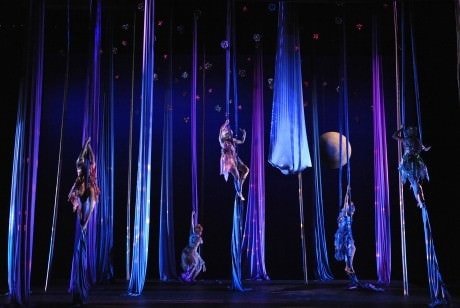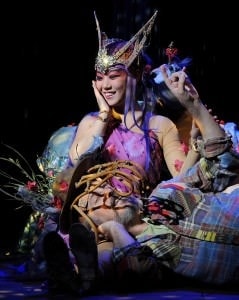A Midsummer Night’s Dream was an extraordinary production with young actors in a partnership between University of Maryland School of Theatre, Dance, and performance Studies and the National Academy of Chinese Theater Arts in Beijing. It is a mash up of three traditional theatrical forms – Beijing Opera, American Folk Music, and Shakespeare. It was the brainstorm of Helen Huang, who suggested the partnership to her fellow professor Mitchel Hebert, who ended up co-directing this production with Jan Fanlin from the National Academy. Apparently much collaborating happened over Skype in the 2 years it took to bring this together.

The night was pure magic. Part of that is because of the play itself, which was a perfect choice to meld these very different art forms. The play begins with Li Xuexi (Theseus) and Sun Shangqi (Hippolyta) onstage in gorgeous costumes from Laree Lentz made of brocaded Chinese traditional costumes and impressive gold head pieces. They speak Chinese and screens provide the subtitles on the side of the stage. Just when you grow used to that, American actors playing the commoners who want to put on a play for them wander on stage singing an American folk tunes. The group includes the hilarious David Demke (Bottom). It is a bizarre transition and for a moment I was worried things weren’t going to going to gel, but moments later Puck, skilled acrobat and actor Du Shuaiqaing, back flips onto the stage and it all fits, because Shakespeare wrote about a dream, and like no other production of this play I have seen, the directors have have created one.
This production is gorgeous and ridiculous and moving and funny. The scenic design by Andrew Kaufman makes a forest out of long lengths of colored cloth, bamboo and the saturated light of Sarah Tundermann’s design. The fairies literally fly, climbing the cloth to do aerial dances choreographed by Andrea Burkholder. The beautiful costumes extend the dream with soft flowing fabrics and coordinated colors for the lovers, which helps with the mad cap plot. Fairies Emma Lou Hébert, Olivia Brann, Anna Lynch, and Riley Bartlebaugh were all wonderful actors. These normally minor roles took center stage during every transition as they danced all around (and over) the stage.
Beijing opera is only distantly related to opera as we think of it. In this production, lines were spoken, interspersed with a few songs, as well as mime, dance and acrobatics…and in this case, some serious…and hilarious physical comedy.A gorgeous musical score and sound design by Matthew M. Neilson and original songs by Mark Halpern and Aaron Bliden (who also musical directed) complete the package. They played with both Chinese music and instruments and a folk musical tradition and instruments, banjoes, guitars and the like. It was a part of this combination that couldn’t possibly work – but did.
Titania and Oberon, by Li Xuexi and Sun Shangqi again, traditionally doubling up as Theseus and Hippolyta, as well as Shi ting and Dong Weijun as Lysander and Hermia and Kong Lingpeng and Li Jiaqiu as Demetrius and Helena are all talented and clearly well-trained, but, what’s more, they and all of the cast, seemed to be having so much fun. The acting style of Beijing opera is slightly more stylized and physical than ours, but it fits the play perfectly. Their sense of comic timing is impeccable and the physical comedy as well is impressive and hugely funny particularly when Oberon and Puck were onstage. When those two are together, it’s impossible not to laugh. The entire play is mined for laughs, physical gags, mimes, and miscommunications far beyond what even Shakespeare could have invented. But the moments between lovers are tender and played well too, and a fight between Puck and Demetrius was pure art and an impressive feat of athletic ability.

The play-within-a-play did not seem like a footnote as it sometimes can, as the American actors take on the style and costumes of a Beijing opera, mimicking what was so serious a few moments before. What was an absolutely stunning entrance by Titania earlier in the play, a dance with two long rainbow-hued scarves, became hilarious when Bottom wrestled with his own flowing sleeves and died fabulously.
By this point, I didn’t even notice that the actors were speaking different languages to each other and half the subtitles were in English and half in Mandarin. I was just laughing. They have fun with the language themselves, as at one moment a bilingual actor switches languages and Puck asks in English for her to please speak Chinese. The translation sometimes did not sync with the actors, but the only reason I noticed was because every actor was so excellent at conveying with their expressions and body exactly what the words meant, so it was almost unnecessary.
These different styles and different cultures are not so distant from each other. The story of true love is a universal one and music is deeply important in both America and China. And the over-the-top yet completely serious dream is probably close to how Shakespeare would have performed it in his time. And for all the artistry, a man getting kicked in the balls clearly funny, no matter what the culture, especially when he can somersault across the stage four or five times.
In the end, it is the young actors’ sheer enthusiasm and talent that makes this such a joy to watch. They seemed to revel in every gorgeous moment of this truly unique price of theatre. Most of the audience seemed to agree with a standing ovation at the end.
Running Time: Approximately two hours and 30 minutes with a 15 minute intermission.
A Midsummers Night Dream plays through September 30, 2012 at the Clarice Smith Performing Arts Center – at the intersection of Stadium Drive and Route 193, in College Park, MD. For tickets, call (301) 405-ARTS (2787), or purchase them online.






Hi Jessica!
I really enjoyed reading your DC Theater Arts blog! Your reviews are
great. I found it because I am a student at the University of Maryland in
College Park and you recently reviewed one of our shows here. I am a
communication major specializing in public relations and we’re doing a
project on blogs. I was wondering if I could possibly set up a phone
interview with you to ask questions about your blog, why you’re writing it,
and other ways you need social media. You can reach me through email address.
Thank you!
Erika